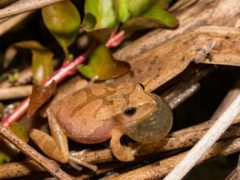March 17th here in the District of Columbia was a typical cool, spring day: overcast and gray, with rain threatening. The temperature was a crisp 50 degrees Fahrenheit, where just the week before it had been sunny and in the seventies. Everyone had emerged from our winter COVID cocoons to get outside and enjoy the unseasonably warm weather while [Read More …]
Nurturing Habitat for Wildlife
City Wildlife hosts Nancy Lawson, The Humane Gardener in a free webinar on Saturday May 15, 10:00 a.m. Why do we call some insects “beneficial” while others are “pests”? Why do we welcome some larger animals to our garden while calling others “nuisances”? Why are some plants considered “desirable” while others are “weeds”? In this myth-busting [Read More …]
Vernal Pools
No sooner has the last snow thawed before these transient, and delicate, habitats are teeming with life. Vernal pools are seasonal woodland bodies of water — some are just large puddles — that flood (with snow melt, then rainwater) for a few months during the spring and dry up by the end of summer. They are critical breeding grounds for many [Read More …]
Living with Raptors: The Tiny Dog’s Survival Guide
Who isn’t struck by the beauty of a majestic hawk soaring effortlessly overhead on a thermal updraft? Owners of small dogs, that’s who. Let’s face it: Hawks, owls, and other raptors don’t know the difference between a pet dog and, say, a rabbit. To them, if the opportunity presents itself, they’re all on the menu. And although attacks on pets [Read More …]
A Happy “Wild Side” New Year’s to All!
On December 3rd, 2020, City Wildlife held our annual celebratory event online. If you missed it, you can now join us for a recorded version of the event, including a tour of City Wildlife, memorable patient stories, a talk on animal intelligence by nature journalist Brandon Keim , and a fun video overview of the work we do year-round. Join us — [Read More …]
The Three Ravens
There were three rauens sat on a tree, downe a downe, hay downe, hay downe, There were three rauens sat on a tree, with a downe, There were three rauens sat on a tree, They were as blacke as they might be. With a downe, derrie, derrie, derrie, downe, downe. -"The Three Ravens" (excerpt), Thomas Ravenscroft c.1611 Many cultures and [Read More …]
Living with Foxes
A Different Kind of Fox News: Recently we received a call about a fox wandering around on the White House grounds. Apparently, he had an injured leg, but that wasn’t slowing him down much. DC Animal Care and Control was notified, but as long as the fox was mobile, there was really no way to help him. In fact, unless the fox were to become [Read More …]
City Wildlife 2020 Virtual Celebration
"Welcome to the Wild Side" City Wildlife Virtual Celebration December 3,2020 @7pm Watch a trailer! Master of Ceremonies: John Kelly Washington Post Metro Columnist Featured Speaker: Brandon Keim Nature and Science Journalist A nature and science journalist based in Bangor, Maine, Keim is the author of The Eye of the [Read More …]
Keeping Fawns Safe
Springtime is baby season for many animals, including the White-tailed deer. You may be lucky enough to spot a fawn in or around your yard. If you see a fawn all by itself, that is normal. Does will leave their fawn for the majority of the day to prevent attracting predators to their baby. They will come back at dawn and dusk to nurse. If you see a [Read More …]
Cohabitating with Deer
The most common human-wildlife conflict with deer is when deer eat the plants in someone’s yard or garden. You can humanely discourage deer from eating your plants. With these simple steps, it’s easy to coexist with deer: Plant deer-resistant native plants. These are plants that deer don’t tend to eat. You can contact your local Cooperative [Read More …]
- « Previous Page
- 1
- 2
- 3
- 4
- 5
- 6
- …
- 9
- Next Page »










